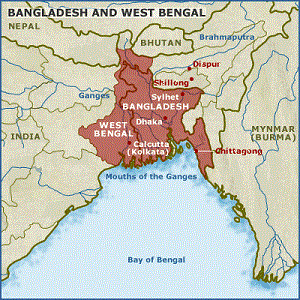
By P.R. Sarkar
(3 January 1989, Anandanagar) – The Bengali race, which is a blending of the Austric, Mongolian and Negroid races, was created about 5000 years ago. Saḿskrta was the language of the land of Bengal before 5000 years ago, hence Saḿskrta is the guiding language of Bengali. The Bengali language underwent a transformation about 1200 years ago. At this time the area of Bengal included the entire present day Bengal, the Jhanpa district of Nepal, the entire eastern portion of Bihar, all of Bangladesh and Burma, the plain portion of Meghalay, and certain portions of Pragjyotispur, Barpeta, Kamrup and Naogaon in Assam. This was the area of the land of Bengal. Today there are two types of Bengali expressions – Indian Bengali and Bangladeshi Bengali. There should be a proper assimilation or blending of both these types.
Bangladesh was created due to the folly of the Indian leaders during the independence movement. They were also responsible for the creation of Assam and Meghalaya. Now the original land of Bengal is Balkanized, and the only reason for the continuation of this situation is the disunity amongst the Bengali people. The unity amongst the Bengali people is the main requirement necessary to solve this problem.
Certain portions of the original land of Bengal are now in Assam. In 1912 during the period of Lord Curzon, because of the folly of national leaders, Bengal was partitioned. After the movement against the partition of Bengal, Bengal was reunited in 1912, but certain portions in Assam and Orissa remained outside the jurisdiction of Bengal. The leaders at that time accepted this plan so there was no objection to this division. This situation should not be allowed to continue. All the portions of Bengal should be reunited. What is essential for Bengal is to develop a sense of unity. Bengal will be de-Balkanized when this unity is developed.
The people of Bengal are more black in the west and southwest, and more yellow in the north and northeast. The people of Bengal have almost the same blood relationship.
The area of Bangalistan consists of the following regions – West Bengal, Tripura, the Bengali speaking areas of Assam, Bihar, Orissa and parts of Nepal, and Bangladesh. How will you unite the fragments and fractures of Bengal? Throughout this area there is socio-economic disparity. In Bangladesh the people suffer from suffocation and natural calamities because there are no develoment schemes. For example, in many places there is only one crop a year and the rest of the time the land is vacant. There should be development schemes in Bangladesh to raise the standard of living of the Bangladesh people. The economic standard of India should also be raised but Bangladesh should be raised more rapidly. Only when there is economic parity amongst Tripura, Bengal and Bangladesh, should India and Bangladesh become united.
Should the people of Bangladesh and Tripura be rehabilitated in West Bengal? No, not at this stage, as this will hamper the development of the people of West Bengal. The best approach is to work for the economic upliftment of the people of Tripura and Bangladesh to ensure their long-term socio-economic progress. There should be a constructive socio-economic movement in Bangladesh. This should include technical education, agricultural development and movements which guide the people away from dogma. All religions encourage centres of dogma. Education should not preach dogma. Education should be free from all the influences of dogma. Next to Indonesia, Bangladesh’s population is saturated and about to burst. As there is disparity in Tripura and Bangladesh, we should think more for the development of Tripura and Bangladesh. Other than the Bengali speaking districts of Dhubri, Goalpara and Barpeta, the economic development of Assam is somewhat satisfactory.
For the development of Bangladesh, what should be done and what should not be done? The main raw materials of Bangladesh are raw jute and hide. Alternatives to jute should be developed, especially in the jute producing centres like the Narayangunge block of Dacca district. Also, there should be maximum utilization of the land by introducing mixed cropping and crop rotation. The adversities of Bangladesh include the education system, natural calamities, malnutrition and lack of economic development.
In Tripura there are two varieties of paddy crops – áus and boro. In Assam there are two major valleys – the Brahmaputra and Barak valleys. In the Karimgange block of Barak valley the quality of bamboo is good and this can be used in the paper industry. Sweet potato and sugar beet can also be grown in the same area. There should be four crops in a year. Synthetic fibre for clothing, medicine, jams, etc. can be manufactured from pineapple. Medicine is made from the leaves of the pineapple plant. Banana stems and leaves can also be utilized, and after the banana plant is burnt, sodium and sodium nitrate can be collected and utilized in the soap industry. Jackfruit grows well in Assam and Tripura, and honey and natural paraffin wax can also be produced.
In Tripura there is laterite soil. In this soil small oranges of the Sylhet variety, cashew nuts and papaya can be grown. Also, small scale industries should be developed. In Amarpur block synthetic rubber should be encouraged in place of natural rubber. This also applies to Jampui Hill region in Panisagar block. Peas, peanuts and white sesame can also be grown. There are good possibilities for utilizing oil and natural gas as well as harnessing solar energy. Solar energy is of a permanent nature and will not run out. Solar energy can also be collected in batteries. Why should energy be imported from outside Tripura?
Copyright Ananda Marga Publications 2012
